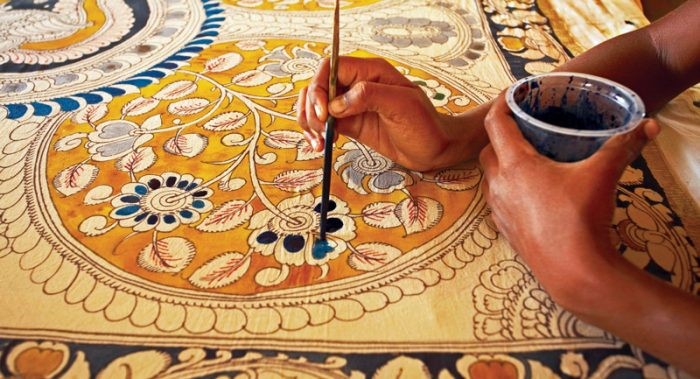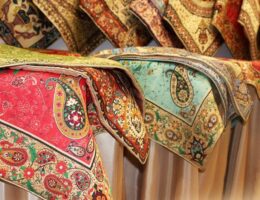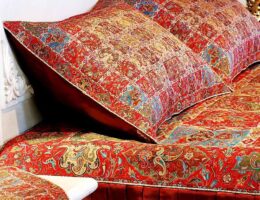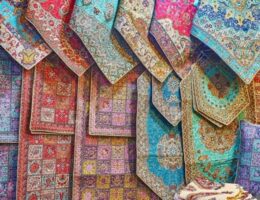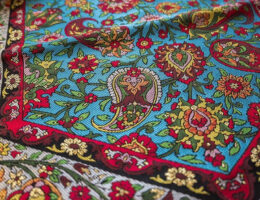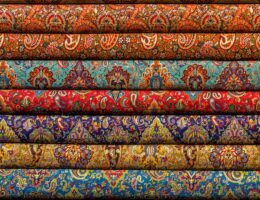IRAN ART EXHIBITION: WHAT YOU SHOULD KNOW ABOUT KALAMKARI HANDICRAFTS
Kalamkari is the art of designing, drawing, and painting on fabric via special pens. Kalamkari is a Persian word borrowed in Hindi. The word is made of two parts (kalam+ kari, literally pen + craftsmanship). And its meaning is ‘an artistic work done by the brush’. The original kalamkari is very delicate and expensive as the artist does it manually from start to finish. kalamkari drawing
The history of kalamkari drawing
There is no clear record about the history of kalamkari. The most detailed comment about it is the one by Phyllis Ackerman in the third volume of the Arthur Upham Pope book. He quotes from an author claiming that this art has started from the Ghaznavid era in 10th century AD in Iran.
However, the archeological findings don’t confirm this claim. Mostly because archeologists have discovered a piece of fabric in the tomb of “Seven Brothers’ Kurgans and Gorodishche” archeological site. They’ve also found another artifact of kalamkari fabric in a graveyard in Egypt, dating back to the same historical period.
Having said that, kalamkari has become common in the Mongol era. To attract the attention of the Mongol khans, Iranians began designing and painting on the fabric. When Safavids came to power, artists from all parts of the country came to their capital, Isfahan, to benefit the supports of Safavids, especially Shah Abbas the Great. That is why even until now Isfahan is the main production area of this art.
A good piece of kalamkari fabric
In the Isfahan market, you can find a wide diversity of kalamkaris with different qualities. Various factors impact on the quality and grade of kalamkari fabric. The first factor is the type of fabric and it should be made of cotton. Otherwise, the fabric does not absorb dyes well and causes defects in the fabric.
Dying in kalamkari drawings
Dyes are one of the most important factors affecting the beauty and price of kalamkari fabrics. It is so because all the dyes used in a noble kalamkari art must be natural. The naturalness of dyes in this art means that artists achieve different colors using natural elements. For example, the artists make the black color of walnut husk and tragacanth. Or they make red of alum, madder, and tragacanth.
Consequently, if the artists use natural dyes and natural methods for fixation of its colors, the product life will extend. In addition to color and fixation, there are other factors that increase the life time of kalamkari art. Designs, stamps and the variety of colors that artists use are important factors in the quality of the kalamkari.
IRAN ART EXHIBITION: Kalamkari fabrics are very beautiful, yet pretty expensive and valuable. Its production and preparation takes a lot of time. Accordingly, most of the fabrics you see in the Isfahan market are not actual kalamkari. In fact, they are printed using patterned wooden stamps and Iranians call them “Chitsazi”. Chitsazi resembles kalamkari fabrics but it not painted with pens or brushes. On the contrary, artists use manual printmaking tools in their production. As a result, the productions of Chitsazi are a combination of kalamkari art and printmaking.
Naqsh-e Jahan historical Square in Iran’s Isfahan, is the center Kalamkari, the special Iranian art of hand printed or hand block printed cotton textiles. Kalamkari is the art of printing and engraving on fabric, which dates back to before the Ilkhanid period. Printing on the fabric was also common in the Sassanid period and engraving on fabric in its modern form was formed during this period.
Then, from the Safavid period and following the support of Safavid kings for this art, masters of the art of Kalamkari came to Isfahan; therefore, this city is known as the center of the art of Kalamkari on cloth. Engraving fabrics by Isfahani creative artists have different uses and are used for tablecloths, bedcovers, prayer rugs, scarves, bags, handkerchiefs, and inscriptions to decorate mourning ceremonies. Most of Isfahan’s Kalamkar artists are based in Naqsh-e Jahan Square and have kept alive the art of engraving on fabrics with their creativity, and the use of new colors and designs. Naqsh-e Jahan Square in Isfahan is one of the beautiful and historical squares of Iran. The square was registered in the list of national monuments of Iran in 1934 and in 1979 it was registered as a UNESCO World Heritage Site.

Kalamkaris originated in Persia (present day Iran) where qalam meant pen and kari meant craftwork. Originally the design was hand drawn onto the cotton cloth using a bamboo pen. But during the 19th century when demand and exports increased, block printing techniques became widely used. Often a combination of block printing and penwork was incorporated into kalamkari production. This example, dating from the late 19th century, has a block printed border whilst the central panel, depicting hunting scenes, is hand drawn.
Wooden print blocks are made from seasoned teak wood. A paste is applied to the surface and allowed to dry. A pattern is then traced onto the wood. The motifs usually consist of leaves, flowers or figurative designs. The negative pattern is cut out using a chisel. Manually operated hand drills are also used. It takes about one week to carve a set of five blocks.
Kalamkaris can vary in design. Some are figurative, some depict the tree of life and others feature repetitive floral motifs and a central lotus flower. The design is often indicative of the region where a kalamkari has been made.
IRAN ART EXHIBITION: Typically produced on cotton cloth, kalamkaris use only natural colours or vegetable dyes. For many centuries, vegetable dyed textiles were traded between Persia and the Machilipatnam region of India.
As part of the production process, myrobalan nuts are soaked, crushed and used to make a filtered solution for treating the cotton cloth prior to printing. A mordant is also prepared for fixing the dyes: alum is dissolved in water to produce a colourless solution, which is then made viscous by the addition of a gum. Pigments such as iron (black), alizarin (red/orange/pink), babol tree bark (brown), indigo (blues), pomegranate shell (yellow) and a mixture of indigo and pomegranate (green) are mixed with rice starch to create colours for the printing process.
In recent years, the increased cost of raw materials and dyes has exerted pressure on this process and fewer craftspeople continue with traditional methods. However, Machilipatnam remains the predominant area for kalamkari production in India, most typically tree of life kalamkaris.
This Persian kalamkari can be seen on display at The South Asia Collection in the new Printed and Painted Textiles exhibition.
